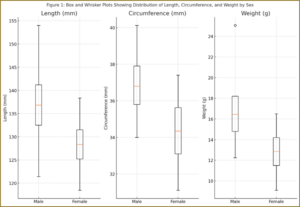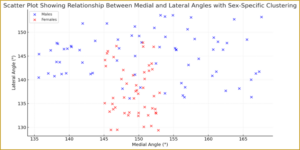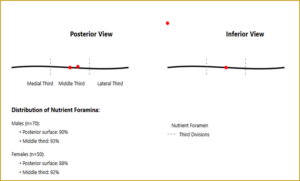Research Article | Vol. 6, Issue 1 | Journal of Clinical Medical Research | Open Access |
Morphological Study of Nutrient Foramen of Left Human Clavicle in Male and Female
Nazia Binte Islam1*





1Assistant Professor (Anatomy), Asgar Ali Medical College & Hospital, Gendaria, Dhaka, Bangladesh
2Assistant Professor (Anatomy), Ibrahim Medical College, Segunbagicha, Dhaka, Bangladesh
3Assistant Professor of Anatomy, Kumuduni Women’s Medical College, Mirzapur, Tangail, Bangladesh
4Assistant Professor (Anatomy), Green Life Medical College, Dhaka, Bangladesh
5Lecturer of Anatomy, Green Life Medical College, Dhaka, Bangladesh
6Lecturer of Anatomy, Green Life Medical College, Dhaka, Bangladesh
*Correspondence author: Nazia Binte Islam, Assistant Professor (Anatomy), Asgar Ali Medical College & Hospital, Gendaria, Dhaka, Bangladesh; Email: [email protected]
Citation: Islam NB, et al. Morphological Study of Nutrient Foramen of Left Human Clavicle in Male and Female. Jour Clin Med Res. 2025;6(1):1-8.
Copyright© 2025 by Islam NB, et al. All rights reserved. This is an open access article distributed under the terms of the Creative Commons Attribution License, which permits unrestricted use, distribution, and reproduction in any medium, provided the original author and source are credited.
| Received 25 December, 2024 | Accepted 11 January, 2025 | Published 18 January, 2025 |
Abstract
Background: The clavicle demonstrates significant morphological variations between males and females, making it valuable for sex determination in forensic investigations. The nutrient foramen’s location and characteristics are crucial for surgical procedures, yet comprehensive morphometric data specific to certain populations remains limited.
Objectives: This study aimed to analyze the morphological variations in left clavicles, focusing on sexual dimorphism and nutrient foramen characteristics, to establish population-specific morphometric standards and enhance surgical and forensic applications.
Methods: A cross-sectional analytical study was conducted on 120 dry ossified left human clavicles (70 male, 50 female) using standardized measurement techniques. Measurements included basic morphometric parameters, angular measurements, curvature characteristics and nutrient foramen features. Data were analyzed using Student’s t-test, with statistical significance set at p≤0.05.
Results: Significant sexual dimorphism was observed in most parameters. Male clavicles showed greater mean length (136.83 ± 6.79 mm vs 128.36 ± 4.43 mm), midclavicular circumference (36.80 ± 1.60 mm vs 34.35 ± 1.89 mm) and weight (16.45 ± 2.76 g vs 12.86 ± 1.94 g) compared to females (p<0.001). Single nutrient foramina predominated in both sexes (92.86% males, 86% females), typically located on the posterior surface (90% males, 88% females) in the middle third of the clavicle (93% males, 92% females). While most parameters showed significant sexual differences, the robustness index and some articular surface measurements demonstrated no significant variation between sexes.
Conclusion: This study establishes comprehensive morphometric standards for the studied population, demonstrating significant sexual dimorphism in most parameters and consistent patterns in nutrient foramen characteristics. These findings provide valuable reference data for surgical procedures, forensic investigations and anthropological studies, while highlighting the importance of population-specific morphometric standards.
Keywords: Clavicle, Morphometry, Sexual Dimorphism, Nutrient Foramen, Forensic Anthropology
Introduction
The clavicle or collarbone, is a unique long bone that lies horizontally at the root of the neck, serving as the only bony connection between the upper limb and axial skeleton [1]. It exhibits considerable variability in shape and size compared to other long bones of the human skeleton, making it a subject of significant interest for clinicians and forensic anthropologists [2]. The clavicle begins ossification before any other bone in the body and is the last to complete its ossification [3]. The nutrient foramen of the clavicle, typically located lateral to the subclavian groove, is a critical anatomical feature that transmits the nutrient artery derived from the suprascapular artery [4]. This vascular supply is essential during active growth, early phases of ossification and various pathological conditions such as fracture healing and acute hematogenic osteomyelitis [5]. Understanding the morphology and position of nutrient foramina is particularly crucial in surgical procedures, including bone grafting and microsurgical vascularized bone transplantation [6]. Recent trends in the treatment of clavicular fractures have shifted from conservative management to interventional techniques, emphasizing the importance of detailed morphometric knowledge for orthopedic surgeons [7]. Additionally, the clavicle demonstrates sexual dimorphism, making it valuable for forensic identification and anthropological studies [8]. The determination of sex from skeletal remains is essential in forensic investigations, with the clavicle showing reliable levels of accuracy in sex discrimination through various parameters including length, weight, midclavicular circumference and rhomboid fossa characteristics [9]. While extensive research has been conducted on clavicular morphometry in various populations worldwide, there is limited data available for certain geographical regions [10-15]. This study aims to analyze the morphological variations of the nutrient foramen in left clavicles, examining their number, position and size, while also investigating sexual dimorphism in these parameters. The findings will contribute to the existing knowledge base for surgical applications and forensic investigations.
Ethical Statement
The study was conducted after obtaining approval from the Research Review Committee (RRC) and Ethical Review Committee (ERC) of Dhaka Medical College, Dhaka.
Material and Methods
Study Design and Sample
This cross-sectional, analytical study was conducted on 120 dry ossified left human clavicles from January 2022 to December 2022 at the Department of Anatomy, Dhaka Medical College. The samples were collected through purposive, convenient sampling [11].
Sample Size Calculation
The sample size was calculated using the following equation:
n = [(Zα + Zβ)² × (σ1² + σ2²)] / (μ1 – μ2)²
Where:
- n = sample size in each group
- μ1, μ2 = means of male and female groups
- σ1, σ2 = standard deviations of male and female groups
- Zα = z-value at 99.99% confidence level
- Zβ = z-value at power 0.99
Based on previous morphometric data from Yang, et al., the calculated sample size was 57 for each group [16]. For convenience, 60 clavicles were taken for each sex, totaling 120 specimens.
Inclusion and Exclusion Criteria
Inclusion criteria comprised morphologically normal dry ossified left human clavicles. Specimens were excluded if they showed:
- Missing or broken parts
- Fractures
- Deformities
- Degenerative changes
Sex Determination
Sex determination was performed using linear discriminant function analysis technique. The technique utilized measurements including maximum length of clavicle and distance of nutrient foramen from the sternal end [17]. Parameters Measured The following measurements were recorded:
- Length of clavicle using digital vernier caliper
- Midclavicular circumference using flexible metallic wire
- Medial and lateral angles using protractor
- Weight using electronic weighing machine
- Anterior and posterior curve lengths
- Depth of medial and lateral curvatures
- Maximum length and width of medial articular surface
- Maximum length and width of acromial surface
- Length and breadth of rhomboid fossa
- Distance of nutrient foramen from sternal end
Observation Parameters
The following features were observed and documented:
- Number of nutrient foramina
- Position of nutrient foramina
- Location of nutrient foramina
- Subclavian groove characteristics
- Types of clavicles
Calculated Indices
The following indices were calculated:
- Robustness index = (Mid-point circumference × 100) / Length of clavicle
- Index of rhomboid fossa = (Breadth of rhomboid fossa × 100) / Length of rhomboid fossa
- Foramen index = (Distance of nutrient foramen from sternal end × 100) / Length of clavicle
- Index of curvature = Medial angle + Lateral angle
Statistical Analysis
Data were analyzed using Statistical Package for Social Science (SPSS) version 25.0. Statistical significance was accepted at p≤0.05. Unpaired Student’s t-test was used for comparison between variables.
Results
The study analyzed 120 dry ossified left human clavicles with 70 male and 50 female specimens. The findings revealed significant morphological variations between males and females across multiple parameters.
- Primary Morphometric Measurements
The length, midclavicular circumference and weight measurements demonstrated clear sexual dimorphism (Fig. 1, Table 1). Male clavicles were consistently longer, with a mean length of 136.83 ± 6.79 mm compared to 128.36 ± 4.43 mm in females (p<0.001). This pattern extended to the midclavicular circumference, where males averaged 36.80 ± 1.60 mm versus 34.35 ± 1.89 mm in females (p<0.001). Weight measurements followed the same trend, with male clavicles (16.45 ± 2.76 g) being significantly heavier than female ones (12.86 ± 1.94 g, p<0.001).
Parameter | Male (n=70) | Female (n=50) | p-value |
Length (mm) | 136.83 ± 6.79 (121.42-154) | 128.36 ± 4.43 (118.48-138.34) | <0.001* |
Midclavicular circumference (mm) | 36.80 ± 1.60 (34-40.12) | 34.35 ± 1.89 (31.11-37.40) | <0.001* |
Weight (g) | 16.45 ± 2.76 (12.25-25.05) | 12.86 ± 1.94 (9.10-16.50) | <0.001* |
*Statistically significant (p<0.001) | |||
Table 1: Primary morphometric parameters of left clavicle by sex.

Figure 1: Box and whisker plots showing distribution of length, circumference and weight by sex.
2. Angular and Curvature Characteristics
The angular measurements revealed significant differences in both medial and lateral angles between sexes (Fig. 2, Table 2). Male clavicles exhibited greater medial (151.60° ± 6.20°) and lateral angles (144.66° ± 5.21°) compared to females (148.28° ± 2.56° and 137.26° ± 5.84° respectively, p<0.001).
Parameter | Male (n=70) | Female (n=50) | p-value |
Medial angle (°) | 151.60 ± 6.20 (135-168) | 148.28 ± 2.56 (145-153) | <0.001* |
Lateral angle (°) | 144.66 ± 5.21 (136-154) | 137.26 ± 5.84 (129-148) | <0.001* |
Anterior curve length (mm) | 137.41 ± 4.97 (124.32-145.24) | 122.58 ± 3.83 (116.39-128.81) | <0.001* |
Posterior curve length (mm) | 147.07 ± 3.42 (142.70-159.73) | 133.76 ± 3.84 (127.51-140.87) | <0.001* |
*Statistically significant (p<0.001) | |||
Table 2: Angular and curvature measurements.

Figure 2: Scatter plot showing relationship between medial and lateral angles with sex-specific clustering.
3. Nutrient Foramen Analysis
The analysis of nutrient foramina revealed interesting patterns in their number, position and location (Fig. 3, Table 3). Single nutrient foramina were predominant in both sexes, with 92.86% occurrence in males and 86% in females. The posterior surface was the most common position (90% in males, 88% in females) and the middle third of the clavicle was the preferred location (93% in males, 92% in females).
Characteristic | Male (n=70) No. (%) | Female (n=50) No. (%) | p-value |
Number | |||
Single | 65 (92.86) | 43 (86.00) | 0.221 |
Double | 5 (7.14) | 7 (14.00) | |
Position | |||
Posterior surface | 63 (90.00) | 44 (88.00) | 0.715 |
Inferior surface | 7 (10.00) | 6 (12.00) | |
Location | |||
Middle third | 65 (93.00) | 46 (92.00) | 0.856 |
Medial third | 3 (4.00) | 3 (6.00) | |
Lateral third | 2 (3.00) | 1 (2.00) | |
*Statistically significant (p<0.001) | |||
Table 3: Distribution of nutrient foramina characteristics.

Figure 3: Composite diagram showing typical nutrient foramen positions and locations.
4. Indices and Derived Measurements
The calculated indices provided additional insights into morphological variations (Table 4). While the robustness index showed no significant sexual dimorphism (p=0.618), the index of curvature demonstrated significant differences between males (296.26 ± 11.07) and females (285.54 ± 6.60, p<0.001).
Index | Male (n=70) | Female (n=50) | p-value |
Robustness index | 26.96 ± 1.83 (22.87-31.97) | 26.80 ± 1.76 (23.17-31.13) | 0.618 |
Index of curvature | 296.26 ± 11.07 (277-319) | 285.54 ± 6.60 (274-298) | <0.001* |
*Statistically significant (p<0.001) | |||
Table 4: Comparative analysis of calculated indices.
These comprehensive results demonstrate significant sexual dimorphism in most morphometric parameters of the left clavicle, with male specimens generally showing larger dimensions. The findings regarding nutrient foramina distribution and positioning provide valuable information for surgical applications and morphological studies.
Discussion
The present study analyzed various morphometric parameters and nutrient foramen characteristics of 120 dry ossified left human clavicles, revealing significant sexual dimorphism and consistent patterns in nutrient foramen distribution. This discussion examines our findings in relation to previous research across different populations.
Length and Basic Morphometry
The mean length of male clavicles (136.83 ± 6.79 mm) was significantly greater than females (128.36 ± 4.43 mm), consistent with findings from multiple populations. Balwar, et al., reported similar sexual dimorphism in Indian populations (males: 141.64 ± 8.54 mm, females: 128 ± 8.32 mm) [1]. Our results also aligned with Kaewma, et al., Thai population study (males: 150.2 ± 0.97 mm, females: 133.5 ± 0.63 mm), though their absolute values were higher, suggesting population-specific variations [2].
The midclavicular circumference demonstrated significant sexual dimorphism (males: 36.80 ± 1.60 mm, females: 34.35 ± 1.89 mm), comparable to Sherawat and Pathak’s findings (males: 38.52 ± 3.28 mm, females: 32.66 ± 2.57 mm) [3]. This consistency across studies reinforces the reliability of midclavicular circumference as a sex determination parameter.
Angular Measurements and Curvature
Our findings regarding medial and lateral angles showed significant sexual differences, with males exhibiting greater angles. This aligns with Dehiya, et al., work, though their absolute values differed slightly (medial angle – males: 152.80 ± 5.7°, females: 150.36 ± 8.5°) [4]. The variation might be attributed to different measurement techniques or population-specific characteristics.
Nutrient Foramen Characteristics
The predominance of single nutrient foramina (92.86% in males, 86% in females) corresponds with Ratnesh, et al., findings (63.33% single foramina) [5]. The preference for posterior surface location (90% in males, 88% in females) mirrors Sinha, et al., observations (55.88% posterior surface) though our percentages were higher [6].
The middle third location prevalence (93% in males, 92% in females) strongly correlates with multiple studies: Sahu and Meher, (66.10%), Rai, et al., (73.8%) and Malukar, et al., (59.10%) [7-9]. This consistency across populations suggests a relatively stable anatomical pattern, likely related to optimal vascular distribution.
Articular Surface Measurements
The sexual dimorphism observed in articular surface measurements partially agrees with Kaewma, et al., findings [10]. However, our study found no significant differences in maximum widths, contrary to some previous studies. This discrepancy might reflect population-specific variations or measurement methodology differences.
Clinical and Forensic Implications
The significant sexual dimorphism observed in multiple parameters supports the clavicle’s utility in forensic sex determination, confirming previous findings by Bagal and Takale [11]. The consistent patterns in nutrient foramen location provide valuable guidance for surgical procedures, particularly relevant given the recent shift toward interventional techniques in clavicular fracture management noted by Sen, et al. [12].
Indices and Derived Measurements
The robustness index showed no significant sexual dimorphism, contrasting with Sherawat and Pathak’s findings [13]. However, the index of curvature demonstrated significant sexual differences, aligning with Dehiya, et al., observations [14]. These variations highlight the importance of population-specific standards in anthropometric studies [18-20]. Comparing our results with international studies reveals both similarities and differences, emphasizing the importance of population-specific data. The consistent patterns in nutrient foramen characteristics across populations suggest fundamental anatomical principles, while variations in morphometric measurements highlight the influence of genetic, environmental and lifestyle factors.
Conclusion
Based on our comprehensive morphometric analysis of 120 dry ossified left human clavicles, several significant conclusions can be drawn that have important implications for both clinical practice and forensic applications. The study decisively demonstrates significant sexual dimorphism in most morphometric parameters of the clavicle. Male clavicles consistently exhibited larger dimensions in length, midclavicular circumference and weight measurements, with statistically significant differences (p<0.001). These findings provide reliable criteria for sex determination in forensic investigations and anthropological studies. The analysis of nutrient foramina revealed consistent patterns, with single foramina predominantly occurring on the posterior surface in the middle third of the clavicle. This anatomical consistency across both sexes provides valuable guidance for surgical procedures, particularly in bone grafting and microsurgical vascularized bone transplantation.
The angular measurements and curvature characteristics showed clear sexual differentiation, with male clavicles displaying greater medial and lateral angles. This information enhances our understanding of biomechanical differences between male and female shoulder girdles and may inform orthopedic surgical planning. Interestingly, while most parameters showed sexual dimorphism, some measurements, such as the robustness index and maximum widths of articular surfaces, demonstrated no significant differences between sexes. This suggests that these parameters may be more influenced by functional demands common to both sexes rather than gender-specific characteristics. These findings contribute to the existing knowledge base of clavicular morphometry and establish population-specific standards that can be valuable for clinical, forensic and anthropological applications. However, further research with larger sample sizes and diverse population groups would be beneficial to validate these findings and explore potential geographical and ethnic variations. The comprehensive data generated from this study provides a reliable reference for orthopedic surgeons, forensic experts and anthropologists, particularly in the context of the studied population. This information can enhance surgical precision, improve forensic identification accuracy and advance our understanding of human skeletal variation.
Conflict of Interest
The authors declared no potential conflicts of interest with respect to the research, authorship and/or publication of this article.
Acknowledgement
Acknowledge those who provided support during the study.
Consent to Participate
Informed consent was obtained from each participant prior to specimen collection.
Financial Disclosure
This research did not receive any grant from funding agencies in the public, commercial or not-for-profit sectors.
Data Availability
Data is available for the journal. Informed consents were not necessary for this paper.
Author’s Contribution
The authors contributed equally.
References
- Balwar TK, Badwaik P, Gajbe U, Singh BR, Anjankar S, Gawali R, et al. Determination of sex by discriminant linear regression analysis of clavicle in vidarbha region. Annals of Medical and Health Sciences Research. 2021;11:150-2.
- Kaewma A, Sampannang A, Tuamsuk P, Iamsaard S. Morphometry of Isan-Thai clavicles as a guide for sex determination. Int J Morphol. 2017;35(1):172-7.
- Sherawat R, Pathak RK. Variability in anatomical features of human clavicle: Its forensic anthropological and clinical significance. Translational Research in Anatomy. 2016;3-4:5-14.
- Dehiya A, Agnihotri G, Sharma R, Sharma A. A morphological and morphometric study on curvatures of clavicle. Int J Medical and Dental Sci. 2019;8(1):1694-5.
- Ratnesh R, Kumar S, Fatima N, Kumar B, Sinha RR, Kumar A, et al. Morphometric study of number, position and direction of nutrient foramen of clavicle in population of Bihar. J Medical Science and Clinical Res. 2018;6:32437-41.
- Sinha SK, Dhan MR, Hayat SMB, Kumar V. Morphometric study in the variations of number, position and direction of nutrient foramen in the Clavicle. Int J Anatomy and Research. 2020;8(2.1):7454-7.
- Sahu SK, Meher D. Morphological and topographical anatomy of nutrient foramina in human clavicles of Eastern Odisha. Int J Applied Research. 2017;521-3.
- Rai R, Shrestha S, Kavitha B. Morphological and topographical anatomy of nutrient foramina in human clavicles and their clinical importance. J Dental and Medical Sciences. 2014;37-40.
- Malukar O, Joshi H. Diaphyseal nutrient foramina in long bones and miniature long bones. NJIRM. 2011;2(2):23-6.
- Standring S. Gray’s Anatomy: The anatomical basis of clinical practice. 40th London: Churchill Livingstone Elsevier. 2008;799-801.
- Bagal G, Takale S. Sex determination from the clavicle. J Medical Science and Clinical Res. 2016;4:11162-5.
- Sen S, Kuntal M, Sharmistha B, Hasi D. Morphometric study of clavicle of eastern indian population. Indian Journal of Basic and Applied Medical Research. 2018;7:295-307.
- Moore KL, Dalley AF, Agur AMR. Clinically Oriented Anatomy. 5th Philadelphia: Lippincott Williams and Wilkins. 2006;425.
- Doshi MA, Reddy BB. Determination of sex of adult human clavicle by discriminant function analysis in the Marathwada region of Maharashtra. Int J Research in Medical Sci. 2017;3859-64.
- Ishwar Kumar IS, Pillay P, Haffajee MR, Rennie C. Sex Determination using morphometric and morphological dimensions of the clavicle within the kwazulu-natal population. Int J Morphol. 2016;34(1):244-51.
- Yang JCS, Lin KJ, Wei HW, Tsai CL, Lin KP, Lee PY. Morphometric analysis of the clavicles in Chinese population. BioMed Research Int. 2017;1-5.
- Cook A, Soames R, Sripada S, Jariwala A. Assessing the variability in clavicular anatomy in a cadaveric study. Orthopedic and Trauma Surgery, Anatomy, Human Identification, University of Dundee, Scotland, UK. 2012;1-2.
- Trangadia MM, Gupta BD. Sex Determination based on morphological study of clavicular rhomboid fossa in Saurashtra Region, Gujarat. J Ind Acad Forensic Med. 2020;42(2):93-8.
- Sadler TW. Langman’s medical embryology. 14th Philadelphia: Lippincott Williams and Wilkins. 2019.
- Sinnatamby CS. Last’s regional and applied anatomy. 12th London: Churchill Livingstone. 2011.
Author Info
Nazia Binte Islam1*





1Assistant Professor (Anatomy), Asgar Ali Medical College & Hospital, Gendaria, Dhaka, Bangladesh
2Assistant Professor (Anatomy), Ibrahim Medical College, Segunbagicha, Dhaka, Bangladesh
3Assistant Professor of Anatomy, Kumuduni Women’s Medical College, Mirzapur, Tangail, Bangladesh
4Assistant Professor (Anatomy), Green Life Medical College, Dhaka, Bangladesh
5Lecturer of Anatomy, Green Life Medical College, Dhaka, Bangladesh
6Lecturer of Anatomy, Green Life Medical College, Dhaka, Bangladesh
*Correspondence author: Nazia Binte Islam, Assistant Professor (Anatomy), Asgar Ali Medical College & Hospital, Gendaria, Dhaka, Bangladesh; Email: [email protected]
Copyright
Nazia Binte Islam1*





1Assistant Professor (Anatomy), Asgar Ali Medical College & Hospital, Gendaria, Dhaka, Bangladesh
2Assistant Professor (Anatomy), Ibrahim Medical College, Segunbagicha, Dhaka, Bangladesh
3Assistant Professor of Anatomy, Kumuduni Women’s Medical College, Mirzapur, Tangail, Bangladesh
4Assistant Professor (Anatomy), Green Life Medical College, Dhaka, Bangladesh
5Lecturer of Anatomy, Green Life Medical College, Dhaka, Bangladesh
6Lecturer of Anatomy, Green Life Medical College, Dhaka, Bangladesh
*Correspondence author: Nazia Binte Islam, Assistant Professor (Anatomy), Asgar Ali Medical College & Hospital, Gendaria, Dhaka, Bangladesh; Email: [email protected]
Copyright© 2025 by Islam NB, et al. All rights reserved. This is an open access article distributed under the terms of the Creative Commons Attribution License, which permits unrestricted use, distribution, and reproduction in any medium, provided the original author and source are credited.
Citation
Citation: Islam NB, et al. Morphological Study of Nutrient Foramen of Left Human Clavicle in Male and Female. Jour Clin Med Res. 2025;6(1):1-8.



